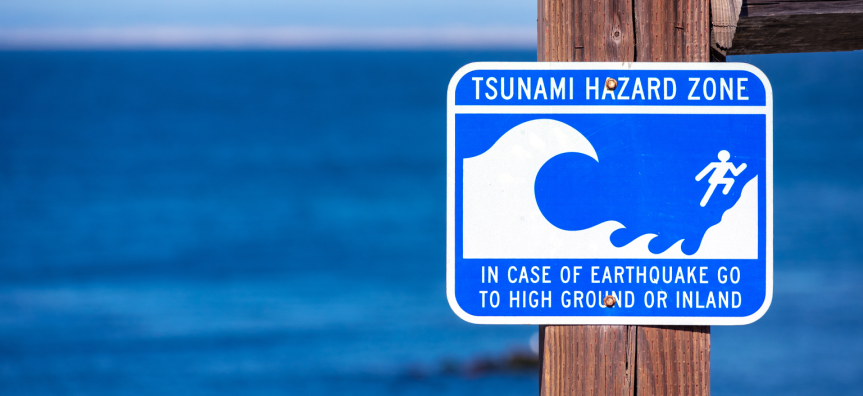
The lead agency for response to Tsunami emergencies is the NSW SES.
A tsunami is a series of waves generated by a number of causes including:
- Vertical movement of the sea floor as the result of a large earthquake
- Submarine or coastal volcanic eruptions
- Meteor impacts
- Coastal landslides and slumps, either land-based or submarine.
Most tsunamis occur in the Pacific and Indian Oceans. The boundary of the Pacific Ocean experiences frequent earthquakes. This boundary is commonly known as the Ring of Fire.
Tsunamis can be generated by a number of causes including volcanic eruptions, undersea landslides and meteor impacts. However, undersea earthquakes are the more likely source of tsunamis that could affect NSW.
Earthquakes from subduction zones are the most common source of a destructive tsunami. These earthquakes are generated when two tectonic plates meet and one goes under the other, usually at a rate measured in centimetres. The sinking (subducting) plate drags against the upper plate, causing flexing. Continued stress on the plate boundary results in the upper plate rebounding to its original position, displacing the sea water above. This can lead to the generation of tsunami waves.
There is a moderate likelihood of a tsunami in the Northern Beaches and NSW compared with other parts of the world, however the consequences of a moderate to large tsunami will have catastrophic risks to our coastal villages. Even with a relatively small tsunami, there could be strong waves, rips and currents and unusual sea levels that can be dangerous. This has the potential to cause erosion and damage to marine structures.
Know your risk
Check if your property is in the NSW SES Tsunami Evacuation Area on the hazards map.
Have a plan
- Put your plan together using the SES Emergency Plans template. Share it with family, friends and neighbours, and review it annually or after an event.
- Your plan should answer all of these questions and more. Take the time to sit and write it down. Do you:
- Know what you would do to protect your property?
- Know where all your important documents are? Insurance, passports etc.
- Know where you will go if you need to evacuate?
- Know what you will take to keep you safe and warm?
- Know what will you will do with your animals?
- Have neighbours, friends or family who may require assistance? Others may have trouble moving during a flood event due to mobility constraints, location or other issues. Consider how you can help others be prepared for a flood event.
- Know who to call to get help?
When a Tsunami Watch is issued
Joint Australian Tsunami Warning Centre issue Official Tsunami Watches, Tsunami Warnings, No Threat Bulletins and Tsunami Cancellations and Tsunami Warning Summaries.
The first stage of the process for warning you about a tsunami is a 'Tsunami Watch' phase. This means that there is the potential for an identified undersea earthquake to cause a tsunami threat to Australia.
If there is a threat, the Bureau will issue a National Tsunami Watch. If there is no threat, it will issue a National Tsunami No Threat Bulletin. If there is a possibility of a Land Threat Tsunami, emergency services may commence evacuations immediately.
People in affected areas:
- Locate your Emergency Kit and add any medications, important papers, special items for babies, elderly, clothing, food and water
- Locate your Emergency Plan
- Keep listening to your local radio station or other media for any updates and advice
- Follow advice given to you by emergency services
Marine and Immediate Foreshore Warning
When a Marine and immediate foreshore threat warning is issued:
- Get out of the water and move to high ground away from the immediate foreshore (beach, rocks, estuary etc.)
- Boats near to shore should be returned and securely moored. Move away from the waterfront to higher ground.
- If your vessel is in deep water and offshore, stay there
- Do not go to the coast to watch the tsunami
- Check that neighbours know about the warning
- Keep listening to the radio for information, updates and advice
Marine and Land Inundation Warning
When a Marine and land inundation warning is issued:
- Move away from foreshore areas and the Tsunami Evacuation Area to higher ground, at least 10 metres above sea level or 1 kilometre inland
- When moving to higher ground take only essential items, such as important papers, family photographs and medication
- It may be in your interests to walk to safety if possible to avoid traffic jams
- If you cannot get to higher ground seek shelter in the upper storey of a sturdy brick building at least 10 metres above sea level.
- Boats near to shore should be returned to shore and securely moored. Move away from the waterfront to high ground at least 10 metres above sea level or 1 kilometre inland
- Do not go to low-lying or foreshore areas to watch the tsunami
- Boats outside harbours, rivers and estuaries should move to deeper water. If your vessel is in deep water and offshore, stay there.
- Check that neighbours know about the warning
- Keep listening to the radio for information, updates and advice
